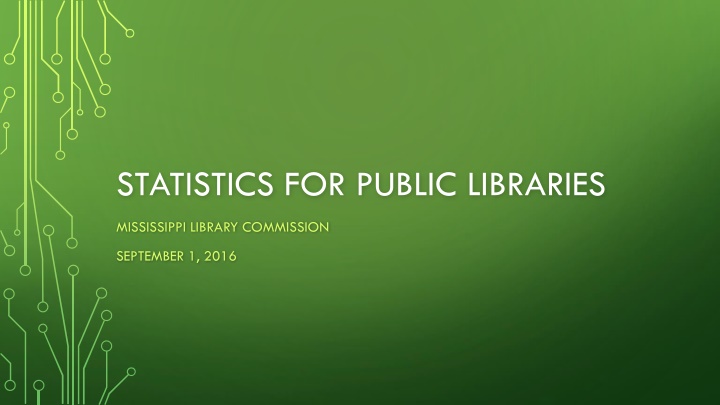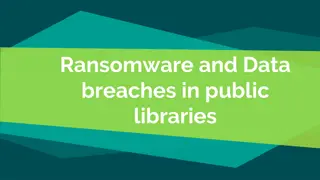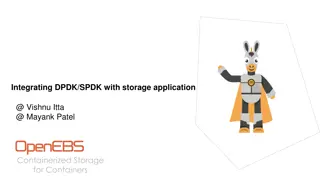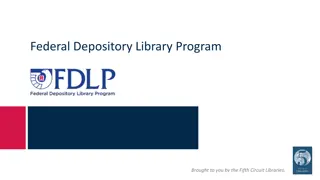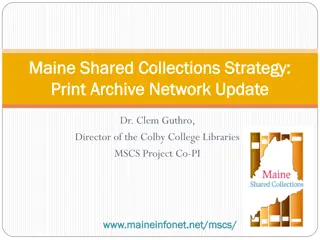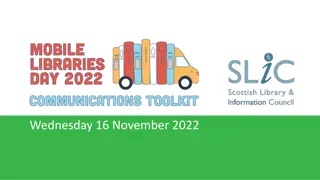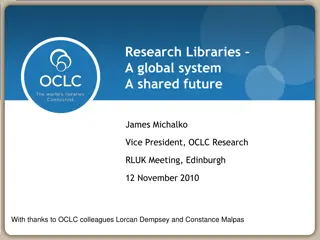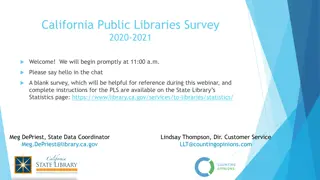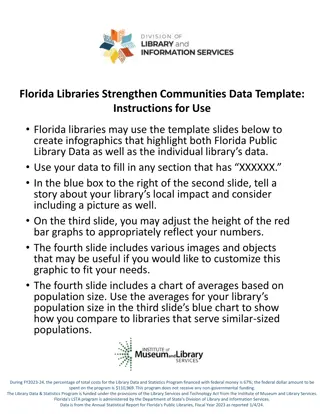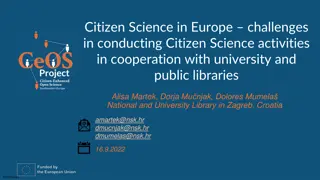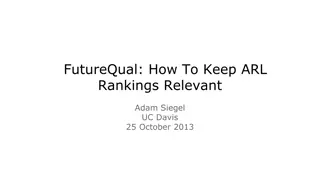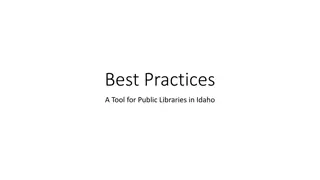STATISTICS FOR PUBLIC LIBRARIES
This survey conducted by IMLS through the Public Library Survey Web Portal provides valuable data for libraries in Mississippi. The survey helps analyze the inputs and outputs of libraries, aiding in goal evaluation and service enhancement. Today's workshop covers general changes to the reporting process, making notes on expenditures and collections, and modifications to existing data elements in library collections.
Download Presentation

Please find below an Image/Link to download the presentation.
The content on the website is provided AS IS for your information and personal use only. It may not be sold, licensed, or shared on other websites without obtaining consent from the author.If you encounter any issues during the download, it is possible that the publisher has removed the file from their server.
You are allowed to download the files provided on this website for personal or commercial use, subject to the condition that they are used lawfully. All files are the property of their respective owners.
The content on the website is provided AS IS for your information and personal use only. It may not be sold, licensed, or shared on other websites without obtaining consent from the author.
E N D
Presentation Transcript
STATISTICS FOR PUBLIC LIBRARIES MISSISSIPPI LIBRARY COMMISSION SEPTEMBER 1, 2016
WHAT IS THIS SURVEY AND WHO MAKES IT? IMLS is the primary source for federal support for libraries and museums. This survey helps to compile the research they do to help us deliver valuable services. States report their data to IMLS via the Public Library Survey Web Portal, which is run by the American Institute for Research (AIR), who does the final data aggregation. Use the data to help you look at your library s functions from year to year. Look at the inputs (dollars, staff time, etc.) and outputs (number of circulations, visitors, etc.) as a starting point to see if you re meeting your goals.
TODAYS WORKSHOP General Changes to the reporting process This year s report Pre-filled or locked items Items that I will populate for you Changes to the current definitions New items Best practices for answering questions. Using your statistics in presentations to funding authorities
LETS GET STARTED. http://collect.btol.com Login/Password Use Internet Explorer Make sure you ve got some coffee handy.
EXPENDITURES & COLLECTIONS EXPENDITURES Make notes about any major changes If your print/electronic materials/other materials budget has fluctuated, make sure to make a note of this, and consider whether the collection numbers reflect that change. COLLECTIONS This should be your total holdings; not just what you ve added this year. On question ____, you may want to list the databases you purchased This helps me know how to tell you to count everything under the new database question.
CHANGES TO EXISTING DATA ELEMENTS IN LIBRARY COLLECTION: Print Materials: Including music scores or other bound forms of printed music Do not include unbound sheet music. Library collection: It does not cover all materials (i.e., microforms, loose sheet music scores, maps, and pictures) for which expenditures are reported under Print Materials Expenditures, Electronic Materials Expenditures, and Other Material Expenditures (data elements #353, #354, and #355). Under this category report only items the library has acquired as part of the collection and catalogued, whether purchased, lease, licensed, or donated as gifts that have been purchased, leased or licensed by the library, a consortium, the state library, a donor or other person or entity. Included items must only be accessible with a valid library card or at a physical library location; inclusion in the catalog is not required. . .
LIBRARY SERVICES NEW DATA ELEMENTS IN THIS SECTION: Physical Item Circulation Successful Retrieval of Electronic Information (database use) Use of Electronic Material (replaces eBook circulation) Electronic Content Use ITEMS THAT ADD UP AUTOMATICALLY: Public Service Hours per Year This comes from all of the hours that you report for your outlet Electronic Content Use Added up from Successful Retrieval of Electronic Info and from Use of Electronic Material Total Circulation of Materials
Rationale: Currently, we have a data element 550 Total Circulation of Material. While the definition calls for annual circulation of all types, SDCs have indicated inconsistency on whether electronic circulation is counted. This proposed element would be a step toward clarifying that. By separating out physical circulation, electronic circulation (those materials that can only be loaned for a given time frame) and use of electronic information, we will then be able to look at use patterns across different types of materials, track change, and better project future use patterns. PHYSICAL ITEM CIRCULATION New Element! This was formally Total Circulation.
Definition: PHYSICAL ITEM CIRCULATION (PT. 2) The total annual circulation of all physical library materials of all types, including renewals. Note: Count all physical materials in all formats that are charged out for use outside the library. Interlibrary loan transactions included are only items borrowed for users. Do not include items checked out to another library. Examples: Books in print Cake pans DVDs CDs Audio Books Playaways
SUCCESSFUL RETRIEVAL OF ELECTRONIC INFORMATION Rationale: This proposed new element is designed to capture the use of online content provided by libraries, but does not require a traditional circulation. Primarily, this element will capture the use of paid, commercial databases. The definition borrowed heavily from NISO standards. This element will capture the use of databases at your library. I will fill in your MAGNOLIA information. You will fill in your local database information.
Definition: SUCCESSFUL RETRIEVAL OF ELECTRONIC INFORMATION (PT. 2) The number of full-content units or descriptive records examined, downloaded, or otherwise supplied to user, from online library resources that require user authentication but do not have a circulation period. Examining documents is defined as having the full text of a digital document or electronic resource downloaded or fully displayed. Some electronic services do not require downloading as simply viewing documents is normally sufficient for user needs. Include use both inside and outside the library. Do not include use of the OPAC or website. [based on NISO Standard Z39.7 (2013) #7.7, p. 43]
Ancestry.com Heritage Quest Rocket Languages (and Mango Languages) Cypress Resume Gale Databases WorldBook Online Zinio ProQuest Databases MOST COMMON LOCALLY-PURCHASED DATABASES We will look at some best practices for counting these databases.
Ancestry Library Edition: Use the total of Citation Image & Text from the summary record.
Heritage Quest: Use the total Citation Abstracts from the summary record.
POPULAR DATABASES GALE VIRTUAL LIBRARIES (& OTHER GALE DATABASES) CYPRESS RESUME ROCKET LANGUAGES Tests/Tutorials/eBooks/Courses added Record views Sessions
POPULAR DATABASES WORLD BOOK ONLINE PROQUEST DATABASES ZINIO Content Views* Record Views Number of checkouts. (This is what Zinio calls this these are not traditional circulation, as users can keep the downloaded periodical indefinitely.)
Remember that your goal is to count: The number of full-content units or descriptive records examined, downloaded, or otherwise supplied to the user, from online library resources that require user authentication but to not have a circulation period.
What your records might look like: This is the number you ll report.
Electronic Materials are materials that are distributed digitally online and can be accessed via a computer, the Internet, or a portable device such as an e-book reader. Types of electronic materials include e-books and downloadable electronic video and audio files. Electronic materials packaged together as a unit and checked out as a unit are counted as one use. Include circulation only for items that require a user authentication and have a limited period of use. USE OF ELECTRONIC MATERIAL This was formerly E-Circulation Change Rationale: This change clarifies language in this element, which was approved last year.
ELECTRONIC CONTENT USE This new element is a calculated field: the total of 552 Circulation of Electronic Material AND 554 Successful Retrieval of Electronic Information. This will populate automatically!
TOTAL CIRCULATION OF MATERIALS This will populate automatically! This new element is a calculated field: the total of 5AA Physical Item Circulation, AND 552 Circulation of Electronic Material.
TOTAL COLLECTION USE This new element is a calculated field: the total of 553 Physical Item Circulation, 552 Circulation of Electronic Material AND 554 Successful Retrieval of Electronic Information. And again this will populate automatically!
LIBRARY SERVICES The rest of these questions are (pretty much) business as usual.
CONNECTIVITY AND OTHER ELECTRONIC INFORMATION Computers and Wi-Fi: Count the computers as usual Count your Wi-Fi! This is a valuable piece of information, even if the number is subjective because of different session lengths. You can count this without spending a lot of money. Use of Public Access Computers in the Library System: Don t forget to do your surveys! At least once a year is necessary, but you ll get better numbers if you do this more often. Don t do percentages. Just do a straight count and multiply by the number of weeks you need to.
OUTLET INFORMATION AND ADMINISTRATIVE BOARDS
DEADLINES/ SCHEDULE October 3: Annual Statistical Report opens Webinar will be October 3 at 10:00 a.m. December 1: Deadline for submitting report Certification letter You must go in and SUBMIT the report. February 13: Drop dead date. May 12: Rough draft of report tables will be sent out to all libraries
USING YOUR STATISTICS PART II
ADDITIONAL SOURCES OF INFORMATION IN MISSISSIPPI Mississippi Department of Employment Security: Monthly Unemployment Rates http://mdes.ms.gov/information- center/labor-market-information/labor- market-publications/ NATIONAL Census.gov, American Fact Finder: http://factfinder.census.gov/faces/nav/jsf /pages/index.xhtml Annie E. Casey Foundation, Kids Count Data: http://www.aecf.org/work/kids-count/
MAKING YOUR OWN INFOGRAPHICS (your design here!)
GENERATING YOUR OWN INFOGRAPHICS: PIKTOCHART Piktochart has many design options, icons, colors, and fonts. Piktochart has good free printing options and decent paid options. Piktochart infographics are shareable on social media.
GENERATING YOUR OWN INFOGRAPHICS: CANVA Free software with paid options Beautiful, designerly layouts Templates for all kinds of presentations: Posters Infographics Reports Social media materials Marketing materials
GENERATING YOUR OWN INFOGRAPHICS: POWERPOINT You can do longer-form infographics or board reports in PowerPoint format using the most recent version of Power Point It s simple, but it can be effective!
Questions? Joy Garretson Library Development Director State Data Coordinator jgarretson@mlc.lib.ms.us (601) 432-4498
